Making Meat: Is Animal Farming Bad for the Planet?
9 minute read
Updated on: 08 Aug 2021
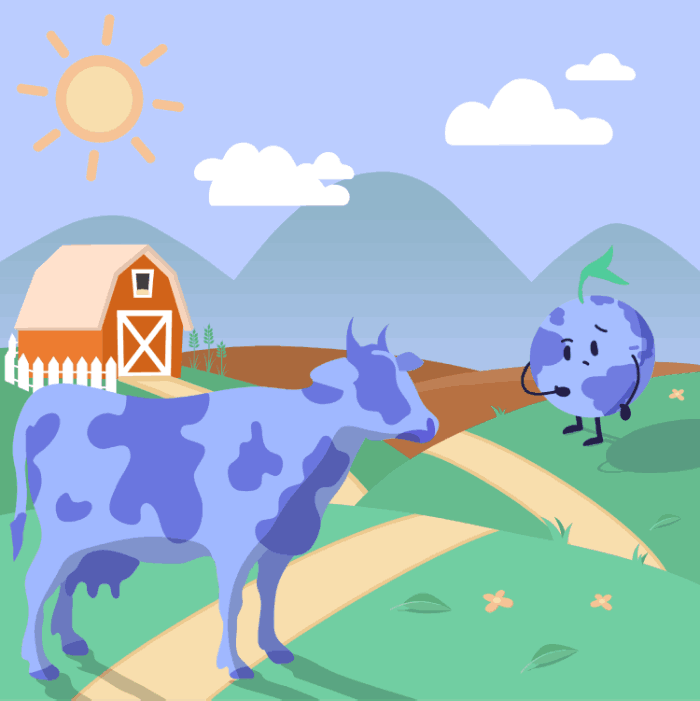
Reducing emissions from meat?
Livestock farming accounts for 14.5% of human-made greenhouse gas emissions.
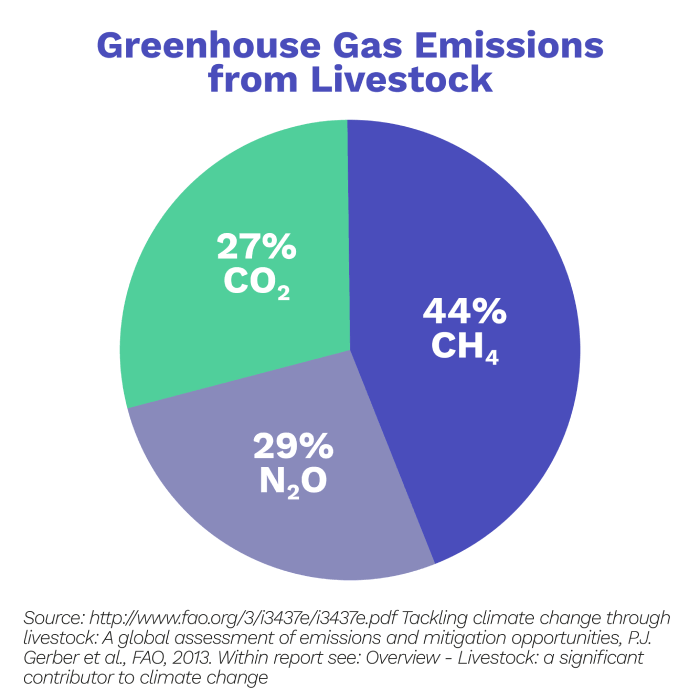
Greenhouse Gas Emissions From Livestock
If you remember, N₂O and CH₄ are much stronger greenhouse gases than CO₂.
Some animal products contribute to emissions more than others.
The worst offenders are ruminants, such as cows and sheep. In fact, ruminants account for 80% of livestock-related greenhouse gas emissions, while providing only 50% of livestock-generated protein. This is largely due to a process called enteric fermentation.
Enteric fermentation occurs when grass and hay are broken down by the millions of microbes that live in the ruminant’s stomach. During this digestion, the microbes produce CH₄, which the ruminant then burps out.

Enteric Fermentation
Animal manure and manure management contribute further to CH₄ emissions, and also produce N₂O.
Overall, ruminants produce 2.7 Gt CO₂eq of methane every year, accounting for about 5.5% of total greenhouse gas emissions from human activities.
Livestock production also occupies 77% of farming land, despite the fact that it provides only 18% of the world’s calories and 37% of protein. This is because land is required to grow animal feed as well as the livestock themselves.
In fact, 33% of croplands are used for animal feed, and feed production is responsible for 41% of emissions from livestock
.
Eating animals is, therefore, a very inefficient way of getting energy.
How can we reduce emissions from livestock production?
It is important to remember that different farming methods have significantly different environmental impacts. For example, high impact beef farms can emit 12x more greenhouse gas than low impact farms.
Let’s have a look at how farmers can reduce their emissions and make livestock production more efficient.
Can animal farms remove CO₂ from the atmosphere?
The grasslands used to rear livestock are able to hold more carbon than land used to grow crops. If livestock grazing is carefully managed, these grasslands could absorb over 1.7% of global CO₂ emissions
. That might not sound like much, but it’s enough to remove 81% of the carbon released from air travel
!
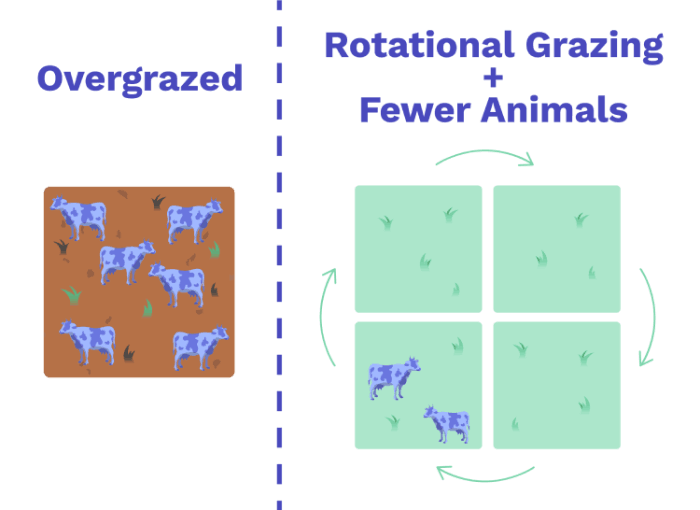
Preventing overgrazing
Manure from livestock improves soil quality and fertility and can increase the potential of the soil to store carbon. Moving animals between different fields allows farmers to manage how much manure builds up, so they can exploit these benefits while minimising emissions of N₂O and CH₄ from unused manure lying on the soil surface
.
However, the potential for pastureland to absorb carbon varies considerably by location, and there is a limit to how much carbon can be stored
. In most cases, converting land back to its natural wooded state will remove more carbon from the atmosphere than keeping grassland for grazing
!
Of course, grass is not the only food that is fed to livestock.
Changes to feed
Enteric fermentation is used to break-down food that is difficult to digest, like hay and straw. Replacing these with more digestible foods could reduce the amount of CH₄ produced per animal
.
For example, including seaweed in a cow’s diet has been shown to reduce CH₄ emissions by over 50%! Seaweed is also rich in many essential nutrients, and doesn’t need to be grown on land
.
To ensure animals receive enough protein, insects can be added to animal feed. Black soldier fly larvae provide a cheap, sustainable source of proteins and other essential nutrients, and can be grown on organic waste, such as manure and kitchen scraps
.
Genetic engineering of feed crops may also be useful in ensuring animals receive all the nutrients they need in the right quantities, while reducing CH₄ emissions (for more information, see previous chapter).
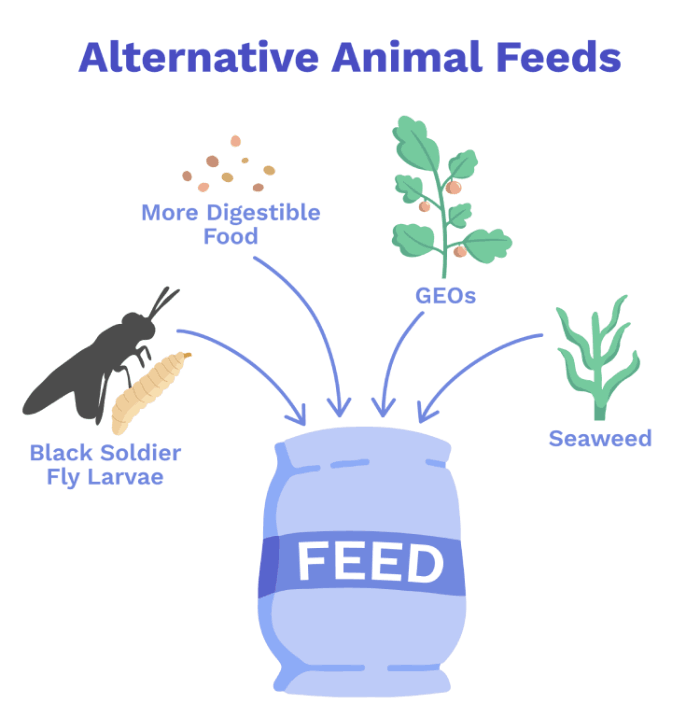
Potential animal feeds
So, we can alter what goes in. What about what comes out?
Waste Management
Microbes in manure convert organic material into CH₄ and nitrogen into N₂O.
All this manure needs to be stored somewhere. Greenhouse gas-producing microbes are more active in warmer, wetter environments, so the conditions under which we store manure will significantly affect emissions
.

Animals make A LOT of manure
In many cases, keeping manure cool and dry requires energy. But what if manure could be used to make energy?
If microbial activity is controlled in a closed container, and in the absence of oxygen, it can be used to produce energy in the form of biogas. This process is called anaerobic digestion
.
The biogas can be burned and used for heating or for generating electricity. However, biogas plants are expensive to set up
, and can cause local pollution
.
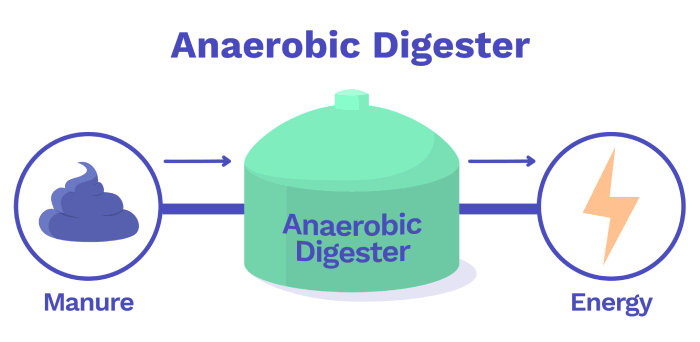
Anaerobic digestion
Can we change the animals themselves?
Animal breeding is another way of reducing emissions from livestock.
More energy efficient animals convert more of their feed into meat or milk. Therefore, fewer of them are needed to produce the same amount of food.
They also retain more nitrogen from their food, so selecting these breeds will reduce N₂O emissions from manure (see previous chapters for more on Selective Breeding).
An animal’s genetics also affect which microbes choose to live in their gut. Some breeds have fewer methane-producing microbes just because of their DNA! Selecting for these breeds will, therefore, reduce methane emissions due to enteric fermentation
.
Genetic engineering of livestock is also an option for increasing livestock efficiency and reducing emissions. It could even be used to make animals resistant to diseases, improving animal health and productivity
. However, there are several ethical and technical issues surrounding genetic engineering of animals, so it may be a while before we see livestock farmers adopting this strategy
.
Reducing consumption
Perhaps the most obvious way of reducing emissions is by reducing how much meat we eat. By removing animal products from our diets, greenhouse gas emissions from the food sector could be reduced by nearly 50%!
However, we’re unlikely to get the whole world to go vegan overnight. In developing countries, livestock provide an important source of nutrients and income, as well as providing essential farm services such as transport and ploughing
.
Considerable emissions reductions can still be made if we reduce how much meat we eat, and shift from beef to lower impact meats, such as chicken.
Conclusion
Livestock are a major source of greenhouse gas emissions and environmental pollution. Changes to farming practices can considerably reduce the negative impacts of this sector on our planet, but farmers can only do so much!
By reducing our meat consumption and shifting to more plant-based diets, we can significantly reduce our individual carbon footprint.
So far we have focused on the problems and solutions for agriculture on land. However, land only covers 29% of the Earth’s surface. What about the other 71%? Next chapter!


